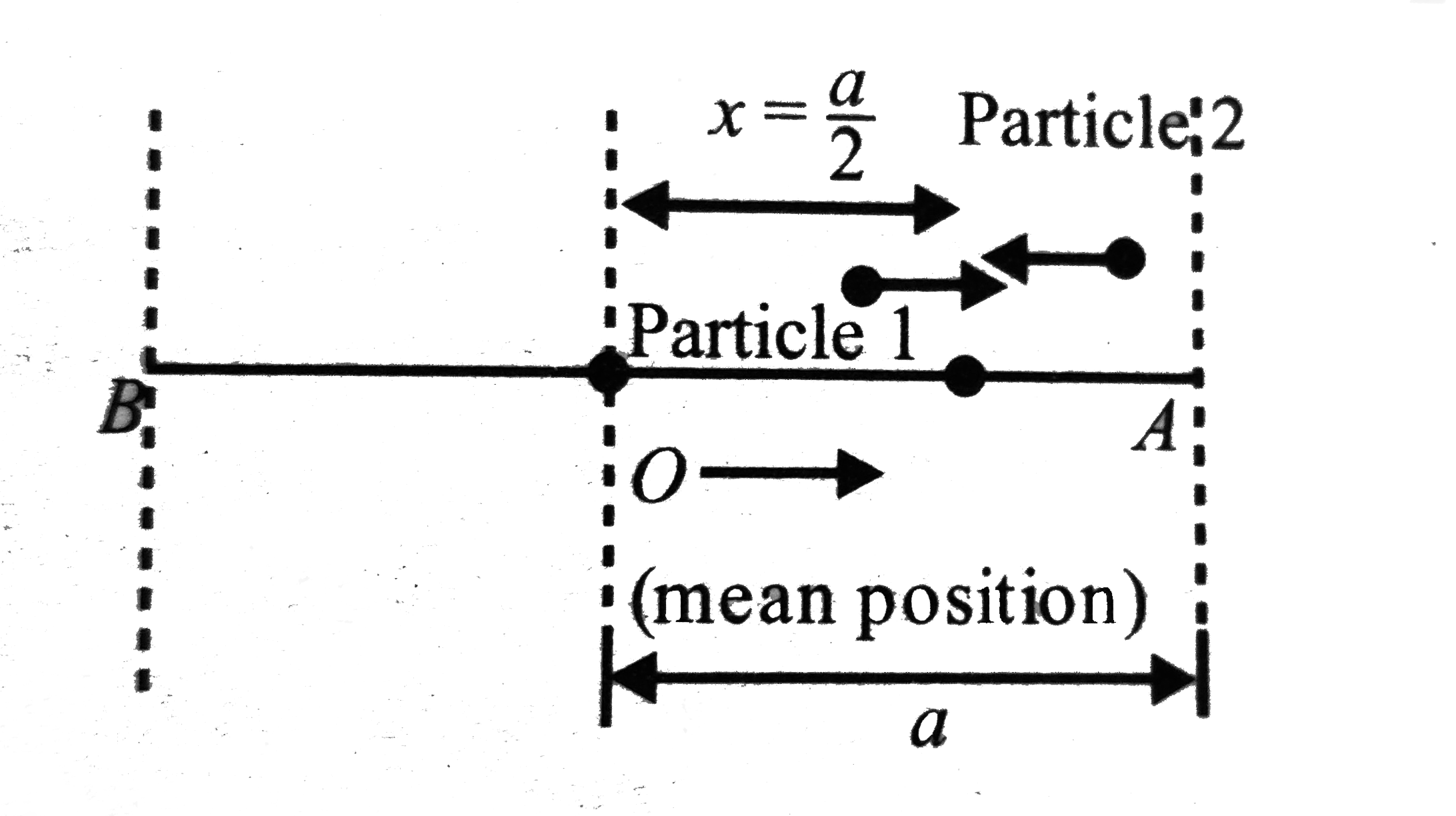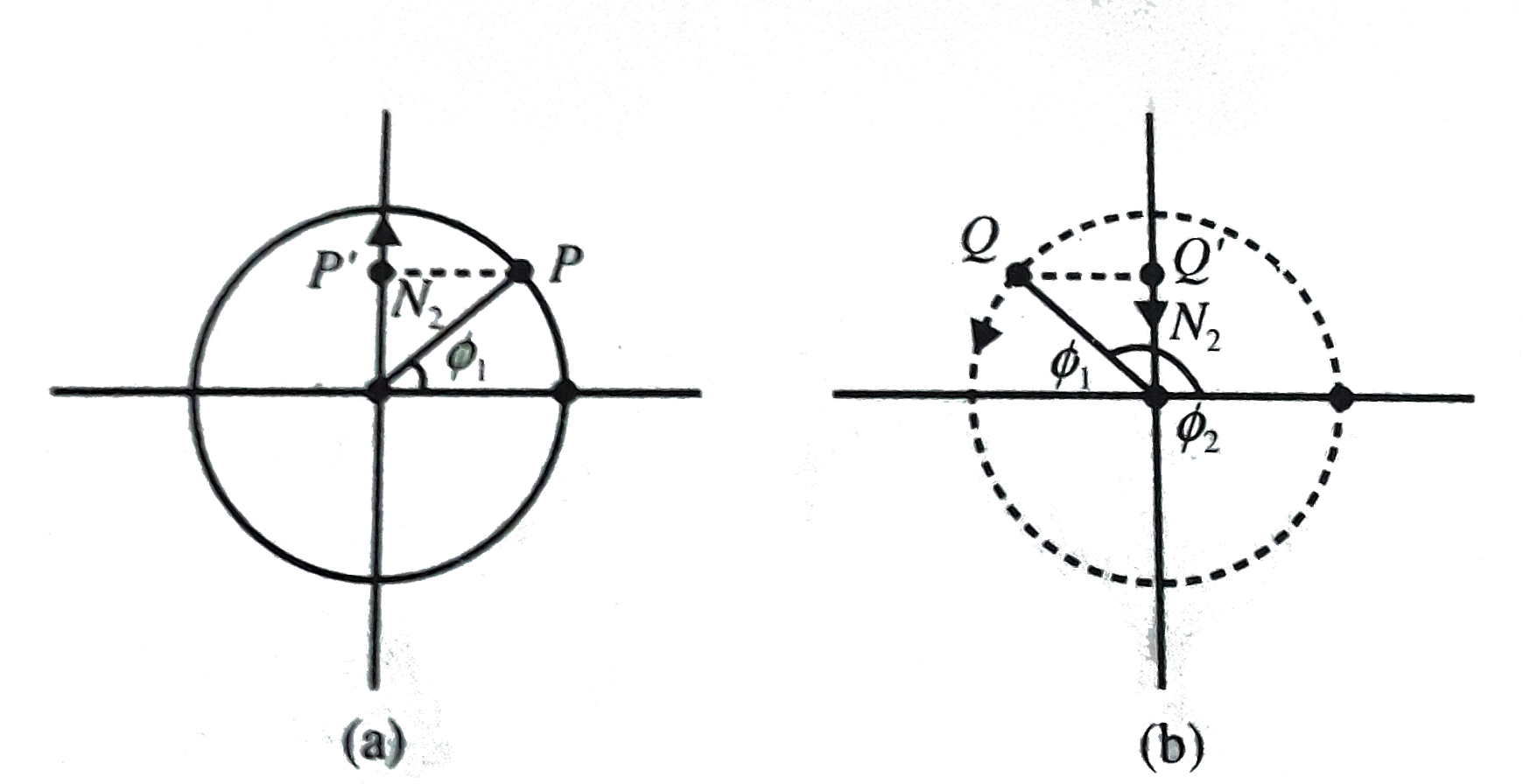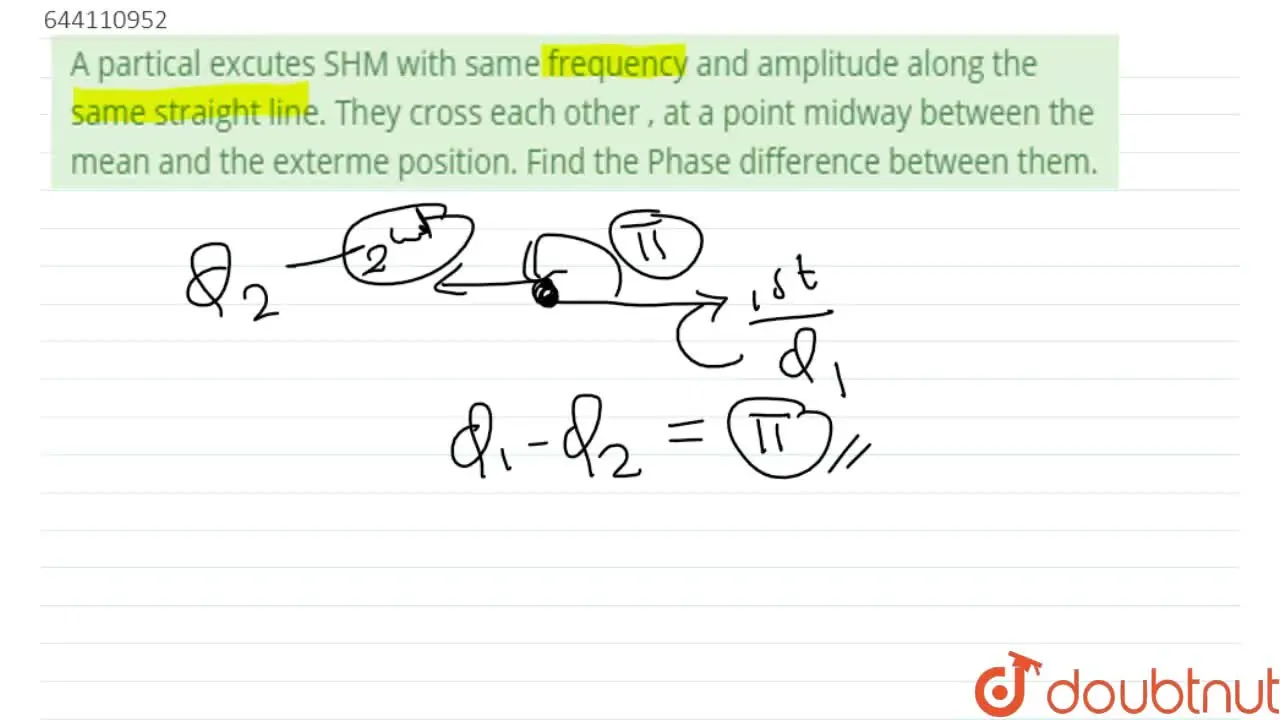A partical excutes SHM with same frequency and amplitude along the same straight line. They cross each other , at a point midway between the mean and the exterme position. Find the Phase difference between them.
Method 1
Let a be the amplitude and ϕ and ϕ there respective phases at any instant ,when they cross each other .
Then their displacement equation can be written as
x=asin(phase)
For the two particals we have a2=asinϕ1anda2=asinϕ2

Taking the least value, ϕ1=π6
and taking the next possible value ϕ1=5π6
Moreover, from ¯v=aωcos(phase)
If ¯v1and¯v2 are the respective velocities of the two particals . The particals cross each other their velocities should be in opposite direction . If we take velocity of the partical 1 positive then velocity of particals should be negative. The velocity of the partical 2 will be negative when it has phase ϕ1=5π/6
Therefore the required phase difference =ϕ2−ϕ1⇒2π3rad
Method 2
figur show that two particals PandQ in SHM along with their corresponding particals in circular motion. Let P move in upward direction when crossing QatA/2 shown in figure

At htis instant phase of P is
ϕ1=sin−1(12)=π6 (i)
Similarly as shown in figure partical Q moves in down wards direction (oppositeP) at A/2, this implies its circular motion partical is in second quadrant thus its phase angle is
ϕ2=π
ϕ1=π−sin−1(12)=π−π6=5π6 (ii)
As both are oscillating at same angular frequency their phase difference remain constant which can be given from Eqs (i) and (ii), as Δϕ=ϕ2−ϕ1=5π6−π6=2π3
Related Playlists
- BOOK - CENGAGE PHYSICS ENGLISHCHAPTER - LINEAR AND ANGULAR SIMPLE HARMONIC MOTIONEXERCISE - Solved Example15videos
LINEAR AND ANGULAR SIMPLE HARMONIC MOTION
- BOOK - CENGAGE PHYSICS ENGLISHCHAPTER - LINEAR AND ANGULAR SIMPLE HARMONIC MOTIONEXERCISE - Exercise 4.123videos
LINEAR AND ANGULAR SIMPLE HARMONIC MOTION
- BOOK - CENGAGE PHYSICS ENGLISHCHAPTER - KINETIC THEORY OF GASES AND FIRST LAW OF THERMODYNAMICSEXERCISE - Interger11videos
KINETIC THEORY OF GASES AND FIRST LAW OF THERMODYNAMICS
- BOOK - CENGAGE PHYSICS ENGLISHCHAPTER - MISCELLANEOUS KINEMATICSEXERCISE - Interger type3videos
MISCELLANEOUS KINEMATICS
Similar Questions
two partical excuting SHM with same frequency and amplitudes Aand2A on same straight line with same mean position cross each other in opposite direction at a distance A/3 from mean possion. Find the phase difference in the two SHM s.
View SolutionTwo particles execute SHMs of the same amplitude and frequency along the same straight line. They cross one another when going in opposite direction. What is the phase difference between them when their displacements are half of their amplitudes ?
View SolutionTwo particles are in SHM with the same amplitude and frequency along the same line and about the same point. If the maximum separation between them is √3 times their amplitude, the phase difference between them is 2πn. Find value of n
View SolutionTwo particle P and Q describe S.H.M. of same amplitude a same frequency f along the same straight line .The maximum distance between the two particles is a√2 The phase difference between the two particle is
View SolutionTwo particle P and Q describe S.H.M. of same amplitude a same frequency f along the same straight line .The maximum distance between the two particles is a√2 The phase difference between the two particle is
View SolutionA particle is subjected to two simple harmonic motions of the same frequency and direction. The amplitude of the first motion is 4.0cm and that of the second is 3.0cm. Find the resultant amplitude if the phase difference between the two motion is
(a) 0∘
(b) 60∘
( c) 90∘
(d) 180∘View SolutionTwo particles execute SHM of same amplitude and frequency on parallel lines. They pass one another when moving in opposite directions each time their displacement is one third their amplitude. What is the phase difference between them?
View SolutionTwo particles execute SHM of same amplitude and frequency on parallel lines. They pass one another when moving in opposite directions each time their displacement is half of their amplitude. What is the phase difference between them?
View SolutionA particle is subjected to two simple harmonic motions in the same direction having equal amplitudes and equal frequency. If the resultant amplitude is equal to the amplitude of the individual motions, find the phase difference between the individual motions.
View SolutionA particle is subjected to two simple harmonic motion in the same direction having equal amplitudes and equal frequency. If the resultant amplitude is equal to the amplitude of the individual motions. Find the phase difference between the individual motions.
View Solution


